Modular external fixation
1. Principles
Modular external fixator
The modular external fixator may be used for temporary or definitive stabilization. It is rapidly applied without need for intraoperative x-rays and can be adjusted later.
The fixator consists of two partial frames (a, b), one on each main fracture fragment. Each partial frame starts with two pins in a bone fragment, connected with a rod. The two frames are joined with a rod-to-rod construction/connecting rod (c).
This allows manipulation and reduction of the fracture after pin placement and guarantees sufficient stiffness of the frame. It also allows pins to be inserted through safe zones, avoiding the zone of injury.
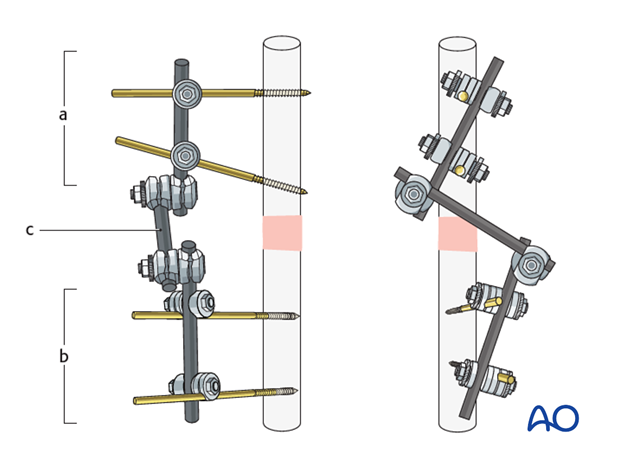
Optimal frame construction
For the construction of the frame consider the following points:
- Pins are placed near the fracture site, but not too close and avoiding the zone of injury (a).
- Pins are widely separated in each main fracture fragment (b).
- Rods are connected to the pins with rod-to-pin clamps (c).
- The rod-to-pin clamps are fully tightened so that each main fragment has its own partial frame.
- In bones with small diameter it may be helpful to insert the pins in an oblique manner (d) for better pin-bone contact.
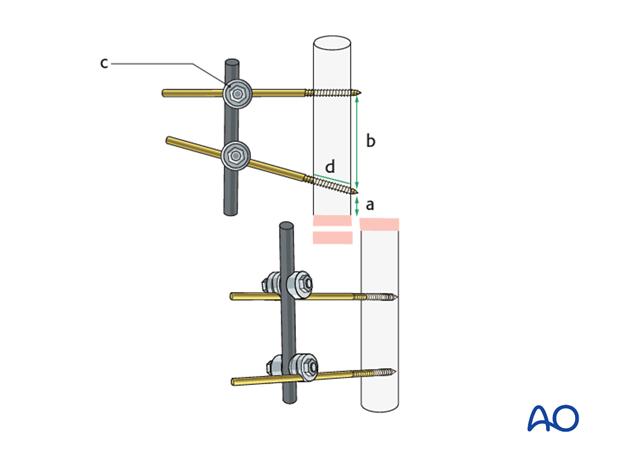
- The two partial frames are joined using a connecting rod.
- The clamps are first provisionally tightened with a T-handle and then fully tightened using a wrench.
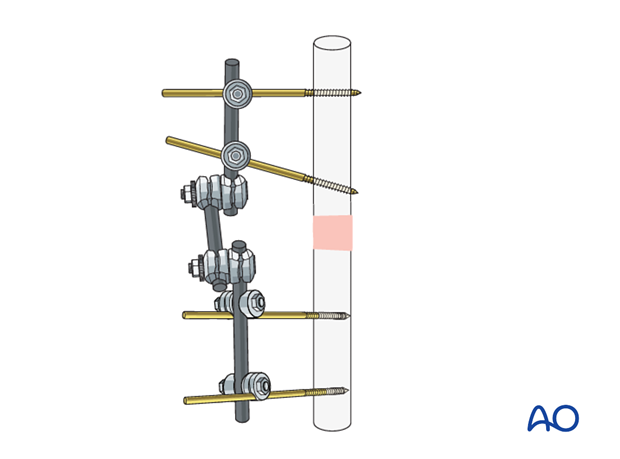
The stiffness of the frame may be increased by the following options:
- Using thicker pins
- Positioning the rod closer to the bone
- Adding a second connecting rod (neutralization rod) (e) between the partial frames
- Inserting additional pins in each segment

These 3D models show the biomechanical behavior of the construct. Increasing the distance from the rod to the bone decreases the stiffness of the frame of the external fixation system. Therefore, the strain at the rod and the pin (especially the outer pin) is increased.
Compressive stress is shown in red and tensile stress is shown in blue in this animation.
These 3D models show that by adding a third pin, the strain concentration at each pin is slightly reduced. The whole construct provides increased stiffness, especially in torsion.
Equipment needed
The following components are needed to construct a large external fixator (the principles for smaller sets are the same):
- Threaded pins (Schanz type pins, standard or self-drilling/self-tapping with radial preload
- Carbon fiber rods or metal tubes
- Rod-to-pin clamps (titanium, MRI safe)
- Combination clamps (rod-to-rod or rod-to-pin, self-holding, titanium, MRI safe)
- Rod-to-pin clamps (old type, still in use)
- Rod-to-rod clamps (old type, still in use)
Selection of a large, medium, small, or mini external fixator depends on the age, anatomic region, and bone size.
The pins, rods and clamps are similar in all systems, but vary in dimensions.
Recommended pin diameters:
- 2.5–4.0 mm for upper extremity
- 3.0–6.0 mm for lower extremity
Recommended rod/tube diameters:
- 4 mm for small external fixator
- 8 mm for medium external fixator
- 11 mm for large external fixator
Additional components may be needed for the application of more sophisticated frames.

2. Pin insertion
Pin placement
Two pins should be inserted in each of the proximal and distal fragments in the safe zones.
The risk of tendon penetration or injuries to nerves, vessels, and muscles is determined by the anatomy of each region. Pins should not be placed where they will enter a joint cavity or growth plate. This is described in the relevant section.
The use of an image intensifier is recommended to facilitate optimal and safe pin placement.
In temporary external fixation, the pins should be placed so that they do not interfere with planned definitive fixation.
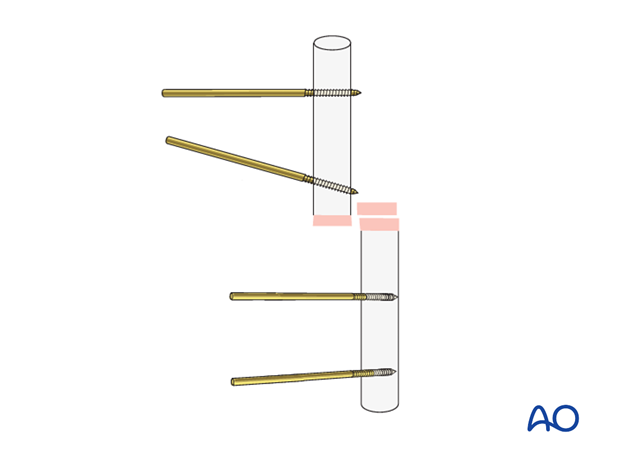
Skin incision
The position of each skin incision is determined by the pin position. As the fracture is reduced, skin movement in relation to the pin should be anticipated. The incision may be extended to release any skin tension.
Predrilling
Unless self-drilling pins are to be used it is essential to predrill both cortices prior to the insertion of threaded pins. This is not necessary for pins up to 4 mm.
The drill should be cooled to prevent thermal bone necrosis.
Place a drill sleeve with trocar through the prepared soft-tissue channel to prevent damage to soft tissues. The use of an image intensifier may be beneficial to determine correct pin trajectories.
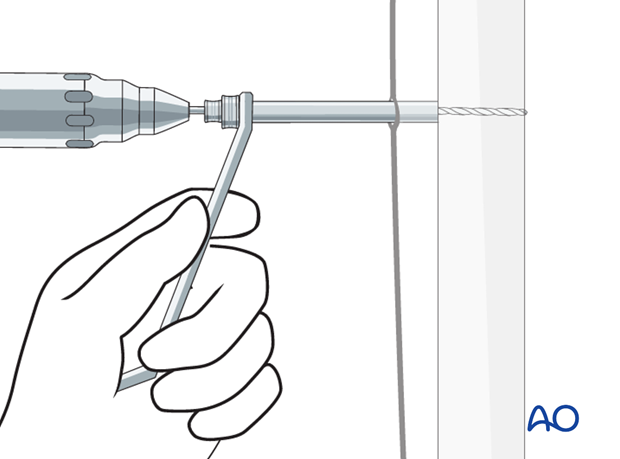
Pin insertion (conventional threaded pins)
Insert conventional pins by hand using the corresponding drill sleeve.
Ensure that the pin includes both cortices; feeling the pin thread engage the opposite cortex confirms correct insertion depth.
It is recommended that the position of all pins is confirmed in two planes using an image intensifier.
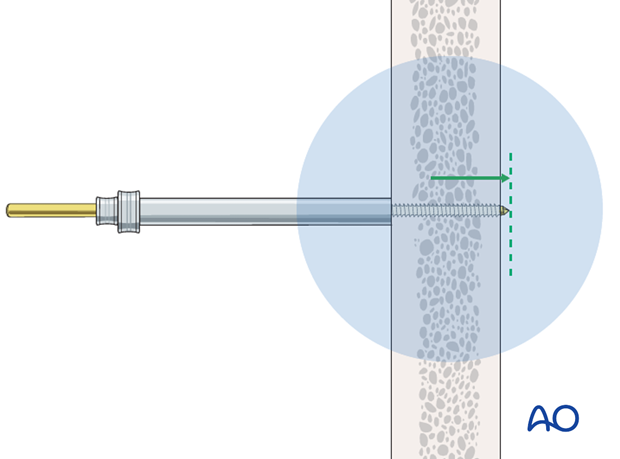
Threaded pins should be inserted so that the thread of the pin is fully engaged in the predrilled hole of the far cortex.
Over penetration of the pins should be avoided as this endangers the soft tissues.
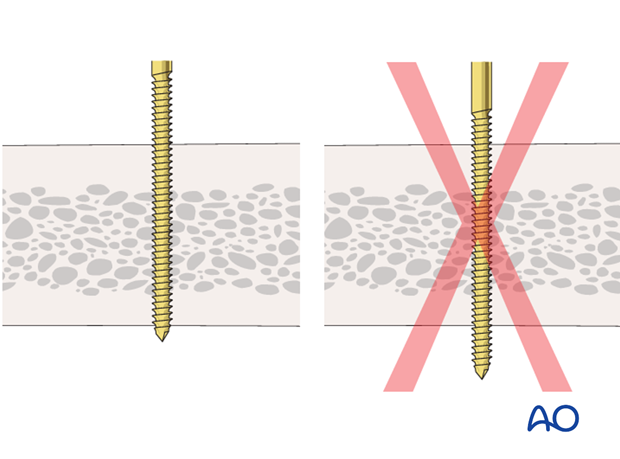
Pin insertion (self-drilling Schanz screws)
Insert each pin through the drill sleeve. A power tool is used to insert the screw thought the near cortex. Once the screw reaches the far cortex, which can be felt easily, turn the pin manually for another one or two rotations to anchor the tip of the screw in the inner side of the far cortex.
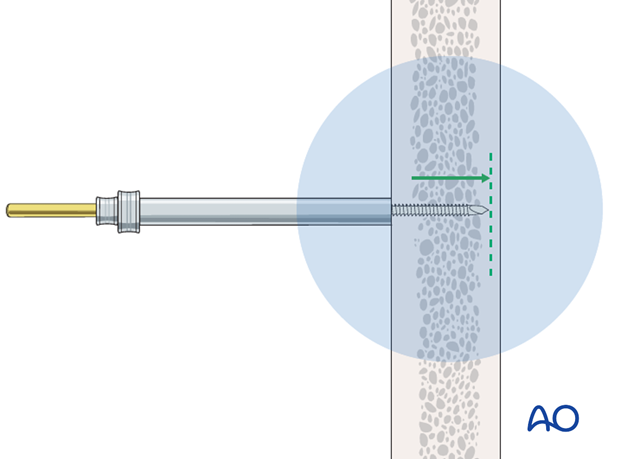
This configuration only applies for self-tapping self-drilling pins.
Self-drilling and self-tapping pins must not perforate the far cortex (the protruding sharp tip can cause soft-tissue injury if it projects beyond the cortex).
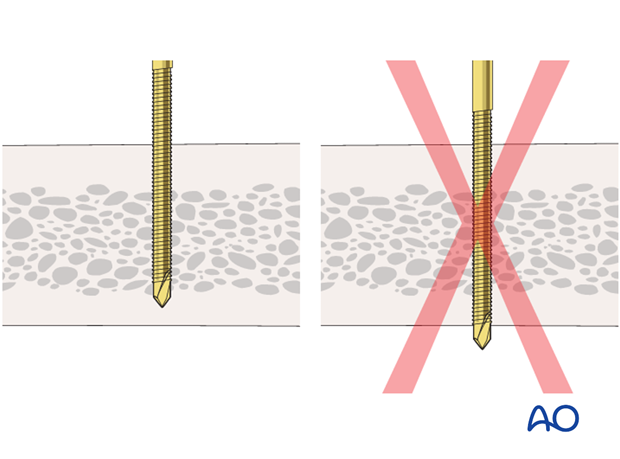
3. Frame construction
Frame assembly
Connect the two pins of each main fragment to a rod using rod-to-pin clamps.
The rod should lie close to the skin, but with sufficient clearance to accommodate subsequent swelling.
There should be enough room between the rod and skin to allow cleaning.
Fully tighten the rod-to-pin clamps to complete the two partial frames.
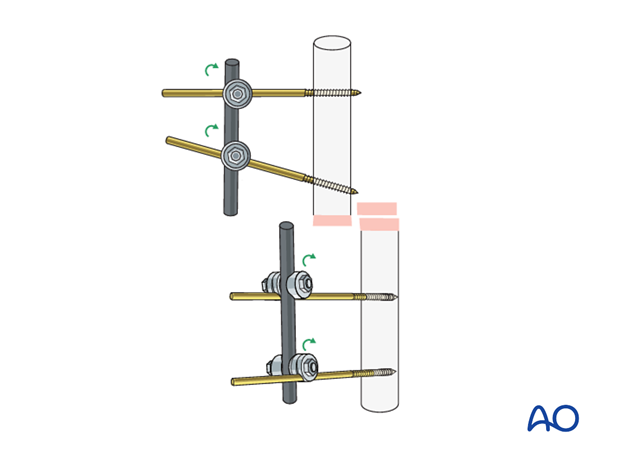
Connect the two partial frames with a rod using rod-to-rod clamps applied loosely enough to allow reduction of the fracture.
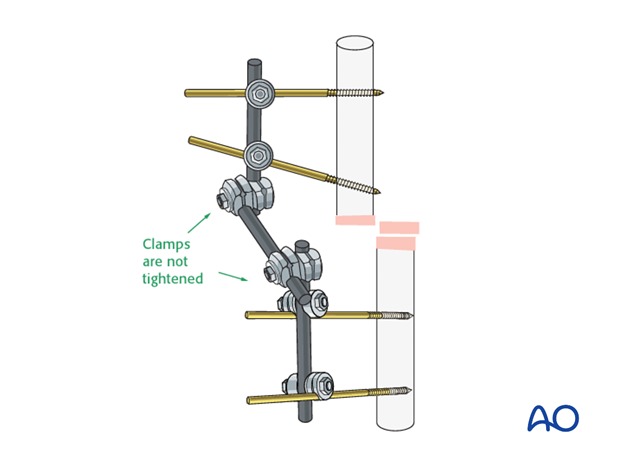
Pearl: shortening the pins
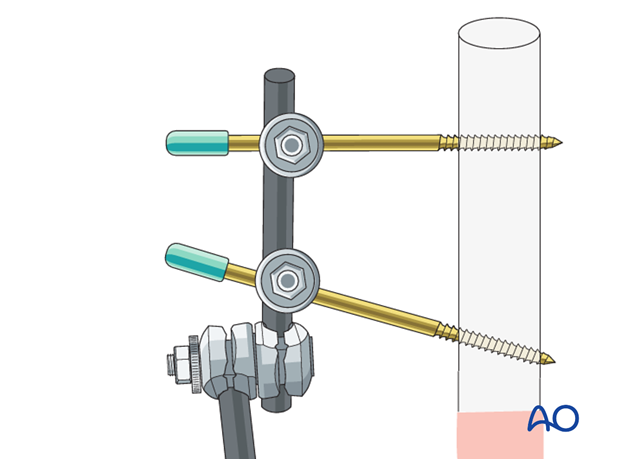
Pitfall: conflicting rods
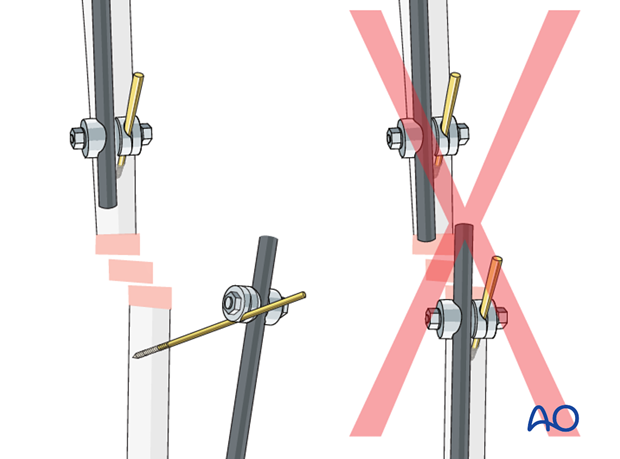
4. Reduction and fixation
Reduction
Using the partial frames as handles, manually reduce the fracture in length, rotation and axis.
Check the provisional reduction in AP and lateral views with an image intensifier if available.
This protects the soft tissues and enables a planned temporary external fixator to be used for definitive fixation.
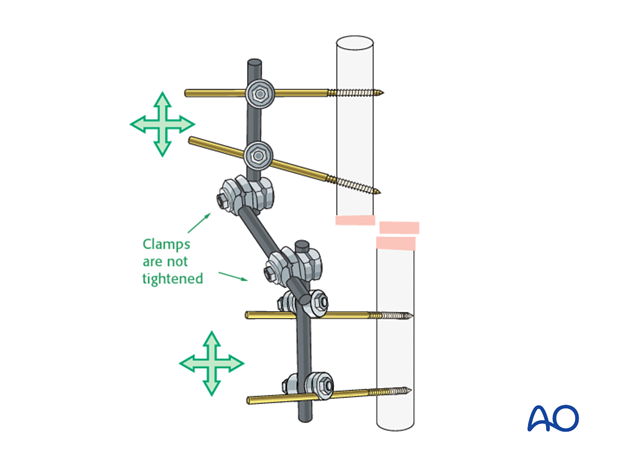
Pearl: lengthening the lever arm
These rods may be attached in whatever orientation is most convenient.
It is then easier to apply the force necessary for reduction and allows the surgeon’s hands to remain outside the image intensifier beam.
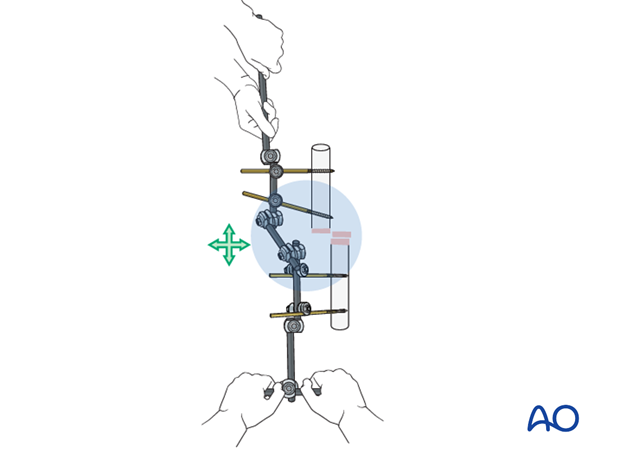
Fixation
When satisfactory reduction has been obtained, tighten the rod-to-rod clamps to finalize the frame construction. Reconfirm reduction with the image intensifier.
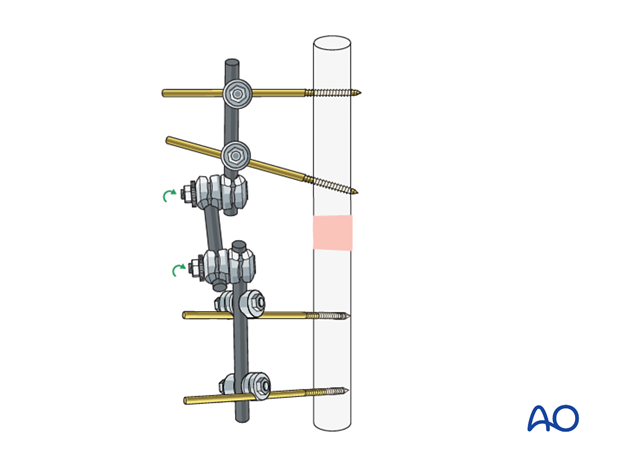
If additional stability is needed to secure the reduction, attach an additional rod (neutralization rod) to the two partial frames.
This may be attached at each end to either a rod or a pin.
A curved rod or two connecting rods may be used.
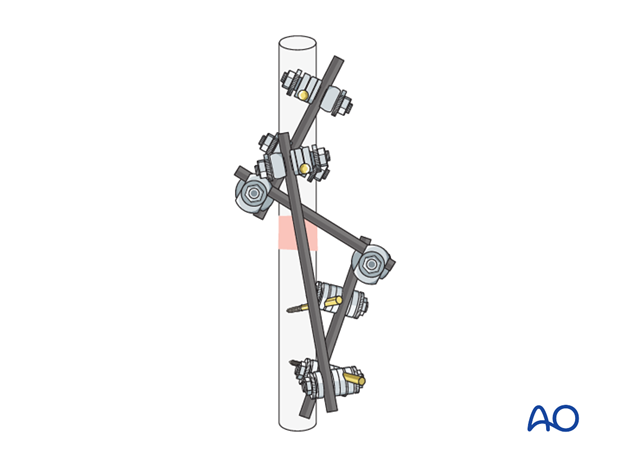
The lower 3D model shows an additional rod (neutralization rod) applied to a modular external fixation frame. This increases the stiffness and the stability of the construct. It adds rotational stability in particular and increases the bending strength, thus significantly reducing strains at the connecting rod.
Periarticular injuries
When the fracture lies close to a joint it may be necessary to stabilize small periarticular fragments with a joint-spanning frame.
In fractures with long healing times this should be converted to a form of fixation which allows the joint to move as soon as is practical, otherwise there is a risk of long-term stiffness.
Associated fractures
In a limb with fractures at more than one site, where both fractures are treated with an external fixator, it may be helpful to join the two frames (eg ipsilateral femoral and tibial fractures).
Inspection and treatment of skin incisions
After the operation, stab incisions should be left open and treated with antiseptic dressings. Closing stab incisions prevents wound drainage, which increases the risk of pin-track infection.
If there is skin tension on one side, the incision should be extended. If significant extension is required so that the total incision is unnecessarily long the redundant portion of the incision may be closed.
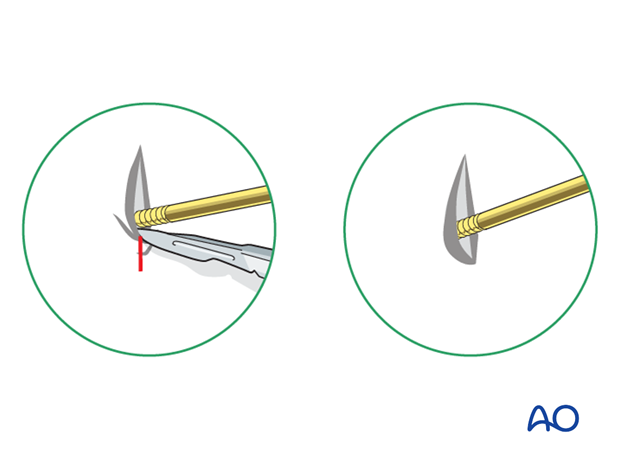
5. Subsequent management after external fixation as temporary fixation
If external fixation was used because the patient was not fit or had a severe soft-tissue injury, definitive fixation may be considered once the general or local conditions have improved.
In children definitive fixation may be with a cast if callus formation is visible.
Healed soft tissues
If the soft-tissue injuries have healed without pin-track infection, the external fixator can be removed and replaced with appropriate stabilization such as internal fixation or a cast.
It should be noted that every pin is colonized after a few days.
Soft-tissue problems persist
Changing to definitive internal fixation in the presence of pin-track infection is associated with an increased risk of implant infection.
If soft-tissue problems persist or there are pin-track infections the following steps should be taken:
- Remove the external fixator.
- Debride the pin sites in the operating theater, using curettage and irrigation, taking specimens for microbiological study.
- Temporarily stabilize in a splint or cast or place a new external fixator with pins at new sites.
- Let the initial pin tracks heal.
- Proceed with internal fixation, covering with antibiotics as determined by positive microbiological cultures or local protocols.
Pitfall: intramedullary infection
6. External fixation as definitive fixation
Indications
In children, fracture healing is often rapid. If external fixation is initially chosen, it could remain until fracture healing.
Adjusting the fixator
A temporary external fixator may be applied rapidly in a severely injured patient.
If external fixation is subsequently chosen as the definitive treatment, the fixator can be adjusted to produce more secure fixation.
It may be necessary to apply a new construct to maintain stable reduction until the fracture has healed.
Pitfall: pin loosening or pin-track infection
- Remove all involved pins and place new pins in a healthy location.
- Debride the pin sites in the operating theater, using curettage and irrigation.
- Take specimens for a microbiological study to guide appropriate antibiotic treatment complementing the surgical debridement.













